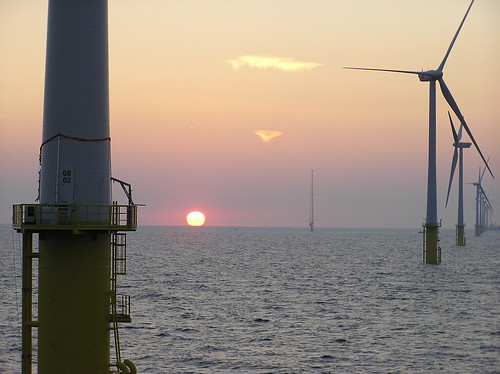 The farm is a 36 turbine, 200 million Euro project built on the initiative of the Dutch government and managed by NoordzeeWind, a joint venture between Nuon and Shell Oil.
The farm is a 36 turbine, 200 million Euro project built on the initiative of the Dutch government and managed by NoordzeeWind, a joint venture between Nuon and Shell Oil.The Planet Green documentary explained how these turbines were set up. They were built in pieces and transported by truck to the coast. From there, they shipped them on giant cargo ships to the sea, where they had to take great care in making sure all the pieces fit perfectly. One wrong move, and the entire turbine would have to be sent back to shore to get fixed.
According to its Wikipedia article, the farm produces a total of 108MW of power, enough to provide 100,000 households with energy.
Since the Offshore Wind Farm near Egmond aan Zee, many other North Sea windfarms have been constructed near the Netherlands, most recently the Princess Amalia Wind Farm (also near Egmond aan Zee) built by Enoco energy, a Dutch energy company, and Econcern, a European company that provides sustainable energy solutions.
After a little more digging (or rather, more link-clicking on Wikipedia), I learned that the United Kingdom is actually the world's leading generator of offshore wind power - makes sense, since space is generally an issue for small island countries. One of the offshore wind farms in the UK, the Lynn and Inner Dowsing Wind Farm, is the world's largest, generating 194MW, enough to power 130,000 homes.
It's great to see energy companies in European countries invest in offshore wind farms. While it may make sea transport a little more difficult, it's an excellent solution to the problem of space, size, and noise issues that wind power is sometimes associated with, and they may be options to consider for many other coastal countries.
Source of images: Flickr Creative Commons







5 comments:
I don't mean to rain on the party here, but I have to believe that sea based wind turbines have to be extremely expensive to operate, finicky to maintain, and relatively vulnerable to any sort of natural disaster. Is is it really a viable alternative? Not really sure :)
Modern wind turbines are built to last for 20 years. Newer models also require much less maintenance compared to the older models, which presents a need to keep investing in the technology to research cheaper and more efficient ways to harness wind power.(http://www.windpower.org/en/tour/econ/oandm.htm).
You're right, offshore turbines are more expensive due to the setup costs of putting the turbine in the water, running underground cables, coating the turbines so they don't corrode, etc. However, there is a greater benefit from economies of scale, especially for smaller countries without much land space, like the UK (http://www.telegraph.co.uk/earth/energy/windpower/3309270/Offshore-wind-farms-clean-and-out-of-sight.html)
There are also newer designs in the works using magnets to reduce friction, allowing for increased power generation and cutting operational costs due to less wear and tear on the gearboxes (http://www.treehugger.com/files/2007/11/chinese_mag_lev.php), as well as designs that involve floating platforms so that turbines aren't restricted to shallow waters near the coast of countries.
As for natural disasters, they probably aren't safe for hurricane prone areas of the world but they are ideal for certain regions like the North Sea, the tip of South America, Australia, the Great Lakes Region, etc. where wind conditions are optimal for wind power (there are global wind map studies to look at ideal locations: http://www.sciencedaily.com/releases/2005/05/050516192202.htm).
well then :)
i like your blog
Alright then, smart guy, let's build wind turbines in all these areas of the world you're talking about. That leaves us with a broad section of the world - the poor community - without access to wind power because of less than ideal wind conditions. What about these guys? Will they be left out of the green revolution?
I think your blog is Satanic!
Wind isn't the end all of alternative energy. For countries without access to suitable wind locations, there is always solar, geothermal, biomass, etc.
The ideal is to make alternative energy cheap enough for even poor countries to be able to afford it. In fact, developing countries are probably an ideal place for the green revolution, since there is the potential to build necessary infrastructure using alternative forms of energy from the very beginning.
Post a Comment